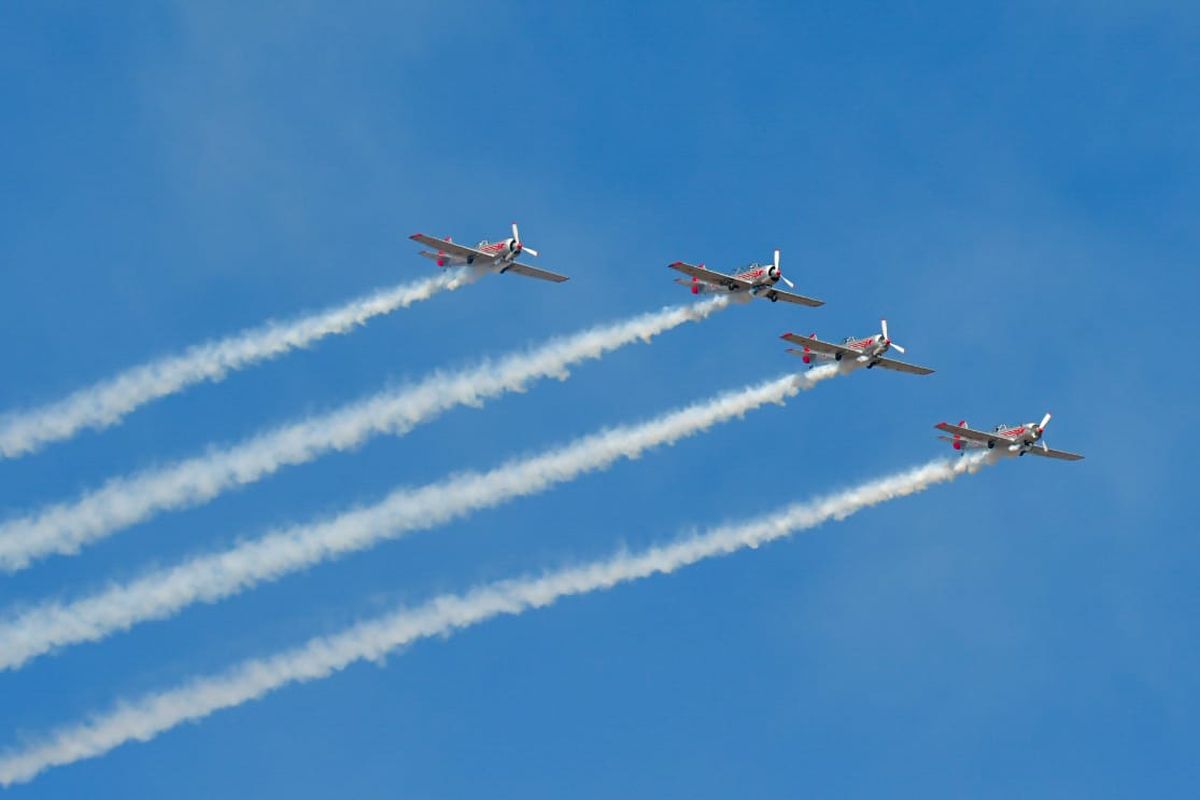The 12th edition of the five-day Aero India 2019, which concluded in Bengaluru on 24 February, saw foreign companies focus on “Make in India”; Union Defence Minister Nirmala Sitharaman painting a rosy picture of the defence and civil aviation sector and, along with Union Civil Aviation Minister Suresh Prabhu, saying the show was the “runway to billion opportunities”.
The show, which is one of the biggest in Asia, saw participation by 600 Indian companies and 200 foreign with 61 aircraft on display, was spread over 28,398 square metres and was indeed impressive. It provided a platform for the much needed boost to encourage Indian and foreign companies to collaborate in the Defence sector.
With the countdown for Lok Sabha elections having begun, questions being raised are how many of these ambitious plans laid out at the show would materialize since most of them were focused on Prime Minister Narendra Modi’s favourite “Make in India”.
Even though the curtain on the show went up amid scenes of huge crowds gathering at the Yellahanka Air Force Station, it was indeed a sombre mood as just a day before the show two aircraft of the Surya Kiran aerobatics team collided while practising, in which a veteran pilot Wing Commander Sahil Gandhi lost his life while two pilots Wg Cdr VT Shelke and Sqn Ldr TJ Singh managed to bail out.
Tejas flight
One of the major attractions at the show was India’s ace badminton player and Olympic silver-medallist P V Sindhu flying in homemade combat fighter jet Tejas on 23 February, highlighting the achievements of women in aviation.
She was the first Indian woman to fly in this aircraft.
She co-piloted the aircraft and her pilot Captain Siddharth said the badminton star coped a force of 5G during her flight. “I am very happy about being the first woman to fly the Tejas. This day is dedicated for women. Hence I will remember this day forever,” Sindhu told reporters after the 40-minute routine. Her flight almost got overshadowed by a massive fire at the show’s car park, in which reportedly about 300 vehicles were damaged.
But, there was indeed a feather in the cap of the Indian fighter aircraft Tejas, which was given the Final Operational Clearance (FOC) by Secretary Defence Research and Development and Chairman of DRDO, G Sateesh. The FOC Certificate and Release to Service Document (RSD) was handed over to the Chief of Air Staff, Air Chief Marshal B S Dhanoa in the presence of Union Defence Secretary and CMD, HAL.
Initial Operational Clearance (IOC) of the aircraft was in 2013 and IOC standard aircraft was inducted into IAF Squadron in July 2016. The IAF Squadron has since successfully flown over 1,500 sorties. Sitharaman exuded confidence at the inauguration saying industry-friendly provisions have been introduced to develop indigenous defence products.
She said, from 2014-15 to October 2018, the Union Defence Ministry had signed 150 contracts totaling about Rs 1,27,500 crore and during the same period had signed “acceptance of necessity” for 164 proposals, amounting to Rs 2,79,950 crore under different categories of “Make in India” programmes.
RFPs had been issued to capital procurement both from within the country and outside.
There was widespread enthusiasm among those visiting the show, with the main attractions being the aerobatics display, not to forget the long queues formed for the caps distributed freely by most of the companies. The show saw several Indian and foreign companies signing agreements for joint ventures in keeping with the government’s ambitious “Make in India”, programme.
Looking ahead
Apart from this, the show gave an opportunity to the French fighter aircraft Rafale, which has kicked up a tremendous political storm, give a display of its capabilities, attracting hordes of visitors to the model of the aircraft parked at the Yallahanka airport tarmac. The crowds were rewarded with a cap and a bag, which indeed appeared to be good publicity for Dassault, the company making the aircraft.
The defence sector got a massive boost with the American company Boeing announcing that it would be accelerating its growth in the country, presenting its strategy and plans while offering advanced capabilities to the Indian armed forces. The core of the company’s strategy is its public-private partnership with India’s defence PSU HAL, with company officials saying, various criticisms of the HAL notwithstanding and the PSU’s reported financial crunch, it has been having a long-term partnership with it.
Boeing and HAL are developing comprehensive plans to set up a new “factory of the future” to manufacture Super Hornet locally. The programme is expected to work with several Indian suppliers to grow a thriving defence aerospace base, which could accelerate other programmes. The facility will create a worldclass, highly trained aerospace workspace.
The American company held talks with its partners Mahindra Defence Systems (MDS) and Hindustan Aeronautics Limited (HAL) on the proposed F/A-18 Super Hornet “Make in India” plan.
The show saw another leading American aircraft company, Lockheed Martin, which is one of the biggest manufacturers of military equipment in the world, unveil its fighter aircraft F-21, specifically made for India, and would be jointly manufactured by Lockheed and Tata Advanced Systems. It is expected to meet the country’s requirement for a Fourth Generation Fighter Aircraft (FGFA). As its vice-president, Strategy and Business Development, Vivek Lall, said, “The F-21 is different, inside and out.”
He said the company is already engaged in the “Make in India” initiative, which was an important aspect of their long term strategy. And with the F-21, it provides unmatched opportunities in this sphere.
Flying high
The show saw the Army Chief General Bipin Rawat flying in HAL’s Light Combat Helicopter (LCH) and saying it was an experience of a lifetime and was suitable for the Army to take on adversaries in any terrain and different altitudes.
Navratna Defence PSU Bharat Electronics Limited (BEL) launched its atmospheric water generator, which would provide safe drinking water straight from the air. The company also signed an MOU with JSR Dynamics for manufacture and sale of Glide Weapons and Light Weight Cruise missiles.
BEL is playing a major role in the government’s Start-up India initiative and has been extending support to start-up companies. JSR is a start up company from Nagpur and this MOU aims at leveraging the individual design and manufacturing capabilities of BEL and JSR to develop weapons.
The first ever “Drone Olympics” of Unmanned Aerial Vehicles (UAVs) made a spectacular entry at the Aero Show and was held to encourage the UAV industry to connect with potential buyers and business partners in the country and also provide an opportunity to the Armed Forces to assess the capabilities of UAVs.
With increasing pollution and airlines burning over billion gallons annually, CSIR and Indian Institute of Petroleum (IIP) are developing a technology for bio-aviation. CSIR-IIP plans to set up a unit for Bio-Jet and renewable diesel. The biojet fuel made by CSIR-IIP is being used 10 per cent as Bio-Aviation Turbine Fuel (ATF) in Spicejet Airlines and also by the IAF. The AN-32 aircraft of the IAF that participated in the Republic Day flypast this year had used 10 per cent BioATF.
New addition
French company Airbus participated in the show in a big way even giving opportunities to the public on the concluding days of the show on February 23 and 24 an opportunity to explore career prospects with Airbus India in Avionics Software, Aircraft System Simulation and Airframe Structures.
The centre piece of the flying displays by Airbus was its new passenger aircraft A330neo, which was the latest addition to its wide-body family, featuring advanced materials, new optimized wing, composite sharklets and highlyefficient engines that together deliver 25 per cent reduced fuel burn.
The A330neo indeed looked sleek as it gave a display at the aero-show, leaving many of the spectators gasping as the sleek aircraft circled the airport slowly several times to give those on the ground a view of all aspects of the aircraft. As the president and managing director of Airbus India and South Asia, Anand E Stanley, said, “Aero India is the jewel in the crown of the world’s largest defence and third-largest commercial aviation market. Airbus’ large scale commitment to the show demonstrates that India is more than a market. It’s a core base for us.”
The French company is also focused on “Make in India” and so is in talks with the Union Defence Ministry to set up a plant in this country to make the C295 aircraft, which, as Anand said, is a multiutlity aircraft. “It is going to be an eye in the sky,” he said. “It can be weaponised, it can be used for medevac. The aircraft can carry 71 troops and as medevac will have on board 24 stretchers.”
As regards Airbus strategy, Anand said three countries are classified as mega countries ~ the US, China and India.
“They are treated separately. India is not just a market but also a base. In the last two years, Airbus has exported one billion dollars of multiple products from here and all non-offset related,” he informed.












